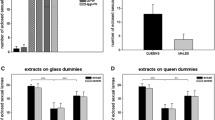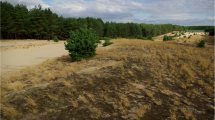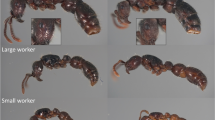Summary
Females ofTechnomyrmex albipes consist of winged queens, intercastes and workers. In established colonies, reproduction is performed by many intercastes (wingless females which have intermediate phenotypes between queen and worker characters). Dissection and morphological examination revealed that intercastes had a spermatheca, but workers did not. Intercastes can be divided into three classes: major intercastes with three ocelli, medium intercastes with one ocellus, and minor intercases without ocelli. Workers have no ocelli. The thoracic structure of intercastes gradually becomes more complex from minors to majors. The body size of intercastes gradually increases from minors to majors, and so does the number of overioles. The body size distributions of minor intercastes and workers overlap considerably, but the distributions of ovariole numbers overlap less. Winged queens had distinctly larger body sizes, more ovarioles and larger spermathecae than intercastes. Most intercastes were inseminated with developed ovaries and appeared to reproduce. The caste system and reproductive division of labour inT. albipes is compared to those of ant species in which permanently wingless females reproduce.
Similar content being viewed by others
References
Bolton, B., 1986. Apterous females and shift of dispersal strategy in theMonomorium salomonis — group (Hymenoptera: Formicidae).J. Nat. Hist. 20:267–272.
Buschinger, A., 1987. Polymorphism and reproductive division of labor in advanced ants. In:Chemistry and Biology of Social Insects (J. Eder, H. Rembold, Eds.), Verlag J. Peperny, Munich, pp. 257–258.
Buschinger, A. and U. Winter, 1975. Der Polymorphismus der sklavenhaltenden AmeiseHarpagoxenus sublaevis (NyL).Ins. Soc. 22:333–362.
Cagniant, H., 1979. La parthénogenèse thélytoque et arrhénotoque chez la FourmiCataglyphis cursor Fonsc. (H. F.). Cycle biologique en élevage des colonies avec reine et des colonies sans reine.Ins. Soc. 26:51–60.
Crozier, R. H., 1982. On insects and insects: twists and turns in our understanding of evolution of sociality. In:The Biology of Social Insects (J. M. Breed, C. D. Michener and H. E. Evans, Eds.), Westview Press, Boulder, Colorado, pp. 4–10.
Francoeur, A., R. Loiselle and A. Buschinger, 1985. Biosystematique de la tribu leptothoracini (Formicidae, Hymenoptera) 1. Le genreFormicoxenus dans la Région holarctique.Naturaliste Can. (Rev. Ecol Syst.) 112:343–403.
Hamilton, W. D. and R. M. May, 1977. Dispersal in stable habitats.Nature 296:578–581.
Haskins, C. P. and R. M. Whelden, 1965. “Queenlessness”, worker sibship and colony vs population structure in the Formicid genusRhytidoponera.Psyche 72:87–112.
Heinze, J. and A. Buschinger, 1987. Queen polymorphism in a non-parasiticLeptothorax species (Hymenoptera, Formicidae).Ins. Soc. 34:28–43.
Heinze, J. and A. Buschinger, 1989. Queen polymorphism inLeptothorax spec. A: its genetic and ecological background (Hymenoptera: Formicidae).Ins. Soc. 36:139–155.
Hölldobler, B. and E. O. Wilson, 1977. The number of queens: an important trait in ant evolution.Naturwissenschaften 64:8–15.
Itow, T., K. Kobayashi, M. Kubota, K. Ogata, H. T. Imai and R. H. Crozier, 1984. The reproductive cycle of the queenless antPristomyrmex pungens.Ins. Soc. 31:87–102.
Le Masne, G., 1956. La signification des reproducteurs aptères chez la fourmiPonera eduardi Forel.Ins. Soc. 3:239–259.
Lenoir, A. and H. Cagniant, 1986. Role of worker thelytoky in colonies of the antCataglyphis cursor (Hymenoptera: Formicidae).Entomol Gen. 11:153–157.
Peeters, C., 1991. Ergatoid queens and intercastes in ants: two distinct adult forms which look morphologically intermediate between workers and winged queens.Ins. Soc. 38:1–15.
Peeters, C. and R. Crewe, 1984. Insemination controls the reproductive division of labour in a ponerine ant.Naturwissenschaften 71:50–51.
Peeters, C. and R. H. Crozier, 1988. Caste and reproduction in ants: nol all mated egg-layers are “queens”.Psyche 95:283–288.
Plateaux, L., 1970. Sur le polymorphisme social de la fourmiLeptothorax nylanderi (Förster), I:Morphologie el biologie comparées des castes.Annls. Sci. nat Zool. 12e série 12:378–384.
Terron, G., 1972a. La ponte des ouvrières fécondés chez une fourmi camerounaise du genreTechnomyrmex Mayr: mise en évidence d'une descendance ouvrière.C. R. Acad. Sci. Paris ser. D 274:1516–1517.
Terron, G., 1972b. Observations sur les mâles ergaloides el les mâles chez une fourmi du genreTechnomyrmex Mayr (Hym., Formicidae, Dolichoderinae).Ann. Fac. Sci Cameroun 10:107–120.
Tsuji, K., 1988. Obligale parthenogenesis and reproductive division of labor in the Japanese queenless antPristomyrmex pungens. Comparison of inlranidal and extranidal workers.Behav. Ecol. Sociobiol. 23:247–255.
Tsuji, K., 1990. Reproductive division of labour related lo age in the Japanese queenless antPristomyrmex pungens.Anim. Behav. 39:843–849.
Ward, P. S., 1981. Ecology and life history of IheRhytodoponera impressa group II. Colony origin, seasonal cycles, and reproduction.Psyche 88:109–126.
Ward, P. S., 1983. Genetic relaledness and colony organization in a species complex of ponerine anls. I. phenolypic and genolypic composition of colonies.Behav. Ecol. Sociobiol. 12:285–299.
Ward, P. S., 1986. Functional queens in the Australian greenhead ant,Rhytidoponera metallica (Hymenoptera: Formicidae).Psyche 93:1–12.
Ward, P. S., 1989. Genetic and social changes associated with ant speciation. In:The Genetics of Social Evolution (M. D. Breed and R. E. Page, Eds), Westview Press, Boulder, pp. 123–148.
Wheeler, W. M. and J. W. Chapman, 1922. The mating ofDiacamma.Psyche 29:203–211.
Yamauchi, K., T. Furukawa, K. Kinomura, H. Takamine and K. Tsuji (in press). Secondary polygyny by inbred wingless sexuals in the dolichoderine antTechnomyrmex albipes. Behav. Ecol. Sociobiol.
Author information
Authors and Affiliations
Rights and permissions
About this article
Cite this article
Tsuji, K., Furukawa, T., Kinomura, K. et al. The caste system of the dolichoderine antTechnomyrmex albipes (Hymenoptera: Formicidae): morphological description of queens, workers and reproductively active intercastes. Ins. Soc 38, 413–422 (1991). https://doi.org/10.1007/BF01241875
Received:
Revised:
Accepted:
Issue Date:
DOI: https://doi.org/10.1007/BF01241875




